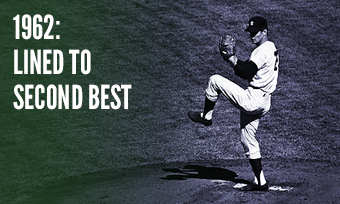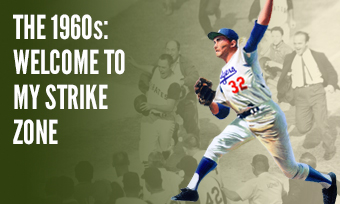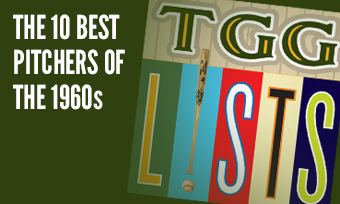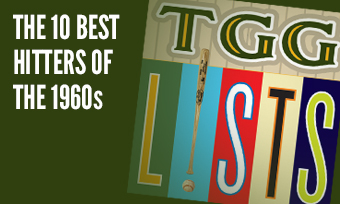The Yearly Reader
Leaders and Honors, 1962
Our list of baseball’s top 10 hitters and pitchers in both the American League and National League for the 1962 baseball season, as well as the awards and honors given to the game’s top achievers of the year.
The National League’s Top 10 Hitters, 1962
Bold type in brick red indicates league leader.
1. Frank Robinson, Cincinnati
Key Numbers: .342 average, 134 runs, 208 hits, 51 doubles, 39 home runs, 136 RBIs, 76 walks, 16 intentional walks, 11 hit-by-pitches, 18 stolen bases, .421 on-base percentage, .624 slugging percentage.
Despite producing better overall numbers than his MVP effort of a year earlier—and despite hitting .370 at home and .390 with runners in scoring position—Robinson settled for fourth place in this year’s vote, in part because a whole of other players were much better, too.
2. Willie Mays, San Francisco
Key Numbers: .304 average, 130 runs, 189 hits, 36 doubles, 5 triples, 49 home runs, 141 RBIs, 78 walks, 18 stolen bases.
Mays, who was not this year’s MVP, was very active when it came to the Giants crossing home plate; he set career highs in both runs scored and runs knocked in.
3. Hank Aaron, Milwaukee
Key Numbers: .323 average, 127 runs, 191 hits, 28 doubles, 6 triples, 45 home runs, 128 RBIs, 15 stolen bases.
Aaron was both tenacious—producing a career-tying 25-game hit streak—and brutal, bashing his longest-ever home run (483 feet) over the faraway center-field wall at New York’s Polo Grounds against the expansion Mets.
4. Tommy Davis, Los Angeles
Key Numbers: .346 average, 120 runs, 230 hits, 27 doubles, 9 triples, 27 home runs, 153 RBIs, 18 stolen bases.
The 23-year-old Davis was averaging over one RBI per game into early August before slightly leveling off; he still broke (and still owns) the all-time Dodgers record—not bad for a guy who never knocked in more than 89 runs in any of 17 other seasons.
5. Orlando Cepeda, San Francisco
Key Numbers: .306 average, 105 runs, 191 hits, 26 doubles, 35 home runs, 114 RBIs, 10 stolen bases.
A nice follow-up to his prodigious 1961 campaign, resettled into his customary position as Willie Mays’ sidekick.
6. Frank Howard, Los Angeles
Key Numbers: .296 average, 25 doubles, 6 triples, 31 home runs, 119 RBIs.
The young Goliath (6’7”, 255 pounds), somehow unable to rack up massive home run totals in two previous years at the Los Angeles Memorial Coliseum, got on track in the first season at pitching-friendly Dodger Stadium; his 31 homers were the most by a Dodger between 1958-73.
7. Maury Wills, Los Angeles
Key Numbers: 165 games, .299 average, 695 at-bats, 130 runs, 208 hits, 13 doubles, 10 triples, 6 home runs, 48 RBIs, 104 stolen bases, 13 caught stealing.
Not Robinson, not Mays; it was the speedy Wills, who broke the all-time season stolen base mark, who also nabbed the NL MVP—though in later years, he’d always be needled by Mays on who really should have won it. (Guess who Willie thought should have won it instead.)
8. Bill White, St. Louis
Key Numbers: .324 average, 93 runs, 199 hits, 31 doubles, 20 home runs, 102 RBIs.
The first baseman and future NL President became a worthy complement to Ken Boyer in the Cardinals’ lineup (to say nothing of a fortysomething Stan Musial), hitting for a personal-best batting average.
9. Eddie Mathews, Milwaukee
Key Numbers: .265 average, 106 runs, 25 doubles, 6 triples, 29 home runs, 90 RBIs, 101 walks.
Although he had gained a reputation for home runs first, all other hits second, Mathews interestingly had two of three career three-double games and one of two career two-triple games in 1962.
10. Felipe Alou, San Francisco
Key Numbers: .316 average, 96 runs, 177 hits, 30 doubles, 25 home runs, 98 RBIs, 10 stolen bases.
Though he wasn’t the first Dominican major leaguer (Ozzie Virgil beat him to it by a year and a half), Alou emerged as the first true star from the baseball-mad island country.
The American League’s Top 10 Hitters, 1962
1. Mickey Mantle, New York
Key Numbers: 123 games, .321 average, 96 runs, 30 home runs, 89 RBIs, 122 walks, .486 on-base percentage, .605 slugging percentage.
Mantle missed a month in the spring to injury and still won his third MVP award—and rather easily.
2. Norm Siebern, Kansas City
Key Numbers: 162 games, 114 runs, 185 hits, 25 doubles, 6 triples, 25 home runs, 117 RBIs, 110 walks.
Siebern was that rarest of players, a former Yankee who came alive after being traded to Kansas City—not vice versa.
3. Floyd Robinson, Chicago
Key Numbers: .312 average, 89 runs, 187 hits, 45 doubles, 10 triples, 11 home runs, 109 RBIs, 72 walks.
No relation to Frank, Floyd Robinson gave Chicagoans hope that his star was on the rise, though his career was peaking in just his second year.
4. Harmon Killebrew, Minnesota
Key Numbers: .243 average, 85 runs, 48 home runs, 126 RBIs, 106 walks, 142 strikeouts.
Killer smashed 31 home runs after the All-Star Break and, on the flip side, broke the AL season record for strikeouts set just a year earlier by Jake Wood—and to be reset again the following year by Dave Nicholson.
5. Rocky Colavito, Detroit
Key Numbers: .273 average, 90 runs, 164 hits, 30 doubles, 37 home runs, 112 RBIs, 96 walks.
Among the year’s highlights for Rocky was producing the first seven-hit game in Tigers history (granted, in a 22-inning marathon against the Yankees), and a home run hat trick at Cleveland in front of Indians fans who longed for his return. (They’d have to wait three more years.)
6. Bob Allison, Minnesota
Key Numbers: .266 average, 102 runs, 24 doubles, 8 triples, 29 home runs, 102 RBIs, 84 walks.
Like his teammate Killebrew, Allison surged in the season’s second half, hitting 23 of his 29 homers after July 1.
7. Al Kaline, Detroit
Key Numbers: 100 games, .304 average, 78 runs, 16 doubles, 6 triples, 29 home runs, 94 RBIs.
Kaline never hit 30 home runs in his Hall-of-Fame career, but he would have easily gotten there—and perhaps even past 40 as well—had he not broken his collarbone and missed 54 games.
8. Carl Yastrzemski, Boston
Key Numbers: .296 average, 99 runs, 191 hits, 43 doubles, 6 triples, 19 home runs, 94 RBIs, 27 grounded into double plays.
Marketed as Ted Williams’ heir in Boston—where he chose the Red Sox over the Reds because Fenway Park was closer to his Long Island home—Yastrzemski thrived in his sophomore campaign.
9. Norm Cash, Detroit
Key Numbers: .243 average, 94 runs, 39 home runs, 89 RBIs, 104 walks, 13 hit-by-pitches.
Opposing pitchers provided some possible payback for Cash using a corked bat in 1961 (if they knew, of course) by hitting him an AL-high 13 times. Still, Cash nearly powered out 40 homers again—though his average collapsed by over 100 points from his .361 mark of a year earlier.
10. Rich Rollins, Minnesota
Key Numbers: .298 average, 96 runs, 186 hits, 23 doubles, 5 triples, 16 home runs, 96 RBIs, 75 walks.
Every bit as good a rookie as any other in the AL, Rollins not only didn’t get Rookie of the Year honors—he didn’t even get a single vote while five others did.
The National League’s Top 10 Pitchers, 1962
1. Don Drysdale, Los Angeles
Key Numbers: 2.83 ERA, 25 wins, 9 losses, .735 win percentage, 43 appearances, 41 starts, 314.1 innings, 232 strikeouts, 11 hit-by-pitches.
Drysdale’s quick start got him to 20 wins faster than any NL pitcher since Hippo Vaughn in 1918.
2. Bob Purkey, Cincinnati
Key Numbers: 2.81 ERA, 23 wins, 5 losses, .821 win percentage, 37 starts, 288.1 innings, 64 walks, 14 hit-by-pitches.
The Reds (98-64) barely failed to repeat as NL champions, despite the peak-year, knuckleball success of Purkey, who learned the pitch from Branch Rickey.
3. Warren Spahn, Milwaukee
Key Numbers: 3.04 ERA, 18 wins, 14 losses, 34 starts, 22 complete games, 269.1 innings, 55 walks.
The 41-year-old southpaw was never more at home than in 1962, gathering 13 of his 18 victories (losing just three) at County Stadium.
4. Billy O’Dell, San Francisco
Key Numbers: 3.53 ERA, 19 wins, 14 losses, 43 appearances, 39 starts, 20 complete games, 280.2 innings, 66 walks, 30 grounded into double plays.
A chance for a 20th victory was denied with O’Dell was removed from a 1-1 tie in the seventh against the expansion Colt .45s in his final start of the year. (The Giants ended up winning the game, 2-1.)
5. Sandy Koufax, Los Angeles
Key Numbers: 2.54 ERA, 14 wins, 7 losses, 26 starts, 184.1 innings, 216 strikeouts.
Missing two months late in the season deprived Koufax of possibly becoming the first modern-era NL pitcher to top 300 strikeouts; he’d get another chance soon enough. In the meantime, he had to settle for his first of five straight ERA titles, his first of four career no-hitters, and an 18-K effort on April 24 against the Phillies to tie the then-major league record co-owned by Bob Feller…and himself.
6. Bob Gibson, St. Louis
Key Numbers: 2.85 ERA, 15 wins, 13 losses, 30 starts, 5 shutouts, 233.2 innings, 95 walks, 11 wild pitches, 10 hit-by-pitches, 23 grounded into double plays.
While he wasn’t quite there yet, Gibson continued to trend toward greatness in his second full season in the Cardinals’ rotation.
7. Jack Sanford, San Francisco
Key Numbers: 3.34 ERA, 24 wins, 7 losses, .774 win percentage, 38 starts, 265.1 innings, 23 grounded into double plays.
Much was made of Billy Pierce’s 12-0 record at Candlestick Park, but Sanford was pretty sharp himself at the Giants’ home base, with a 14-1 mark; at one point, he won 16 straight decisions overall.
8. Bob Friend, Pittsburgh
Key Numbers: 3.06 ERA, 18 wins, 14 losses, 39 appearances, 36 starts, 5 shutouts, 261.2 innings, 53 walks, 28 grounded into double plays.
“Warrior” shook off a wobbly first half—itself on the wake of a 19-loss campaign the year before—and went 10-5 with a 2.12 ERA from mid-July on.
9. Bob Shaw, Milwaukee
Key Numbers: 2.80 ERA, 15 wins, 9 losses, 38 appearances, 29 starts, 225 innings, 45 walks.
With veteran Lew Burdette blowing a tire he’d never recover from, Shaw picked up the slack and became Sidekick of the Year to Warren Spahn.
10. Juan Marichal, San Francisco
Key Numbers: 3.36 ERA, 18 wins, 11 losses, 36 starts, 262.2 innings.
Would the emerging Giants ace have loved to pitch full-time at the team’s former home at the Polo Grounds? Marichal began a three-year run in which he went 6-0 with a 0.55 ERA at the old yard. (Of course, the awful infant Mets were the opponents, so consider the source…)
The American League’s Top 10 Pitchers, 1962
1. Hank Aguirre, Detroit
Key Numbers: 2.21 ERA, 16 wins, 8 losses, 3 saves, 42 appearances, 22 starts, 216 innings.
The eighth-year reliever was elevated to full-time rotation duty after continuously impressing in spot starts—leading to a surprise ERA crown.
2. Jim Kaat, Minnesota
Key Numbers: 3.14 ERA, 18 wins, 14 losses, 39 appearances, 35 starts, 5 shutouts, 269 innings, 13 wild pitches, 18 hit-by-pitches, 34 grounded into double plays.
Four times, Kaat pitched into extra innings—including three starts in a row in early August, two of those on three days’ rest.
3. Ralph Terry, New York
Key Numbers: 3.19 ERA, 23 wins, 12 losses, 2 saves, 43 appearances, 39 starts, 298.2 innings, 57 walks.
Terry may have given up a Yankees-record 40 home runs, but it didn’t seem to affect his overall performance, as he mastered the curve taught to him by pitching coach (and fellow 20-game winner) Johnny Sain.
4. Dean Chance, Los Angeles
Key Numbers: 2.96 ERA, 14 wins, 10 losses, 8 saves, 50 appearances, 24 starts, 206.2 innings, 24 grounded into double plays.
The 21-year-old was one of the primary reasons the second-year Angels were surprisingly competitive; he lost his shot at a first career no-hitter on September 10, giving up his first knock with one out in the eighth at Minnesota.
5. Ray Herbert, Chicago
Key Numbers: 3.27 ERA, 20 wins, 9 losses, .690 win percentage, 35 starts, 236.2 innings, 27 grounded into double plays.
Herbert, who hadn’t pitched above .500 in over 10 years, was the season’s most surprising 20-game winner; collecting W’s in each of his last six starts helped get him to the milestone.
6. Camilo Pascual, Minnesota
Key Numbers: 3.32 ERA, 20 wins, 11 losses, 33 starts, 18 complete games, 5 shutouts, 257.2 innings, 59 walks, 206 strikeouts.
The Cuban native, in his ninth year with the Senators/Twins, finally hit his pinnacle with his first of back-to-back 20-win campaigns, to go along with his third year over the last four pacing the AL in shutouts.
7. Whitey Ford, New York
Key Numbers: 2.90 ERA, 17 wins, 8 losses, 37 starts, 257.2 innings.
Though his numbers seemed to pale against those of teammate/1962 workhorse Ralph Terry, Ford remained the Cadillac of AL pitchers.
8. Eddie Fisher, Chicago
Key Numbers: 3.10 ERA, 9 wins, 5 losses, 5 saves, 57 appearances, 12 starts, 182.2 innings, 45 walks.
The arrival of Fisher from San Francisco as their top reliever eased the pain of giving up 1950s ace Billy Pierce to get him.
9. Robin Roberts, Baltimore
Key Numbers: 2.78 ERA, 10 wins, 9 losses, 25 starts, 191.1 innings, 41 walks.
Following dismal numbers (1-10, 5.85 ERA) in his last season with the Phillies, Roberts signed with the Yankees, never played, was released and considered quitting—but the Orioles rescued him, and he responded with an unusually taut and successful campaign.
10. Dick Donovan, Cleveland
Key Numbers: 3.59 ERA, 20 wins, 10 losses, 34 starts, 5 shutouts, 250.2 innings, 47 walks, 26 grounded into double plays.
Donovan received a welcomed exile from Washington to Cleveland and earned the 20 wins he should have got the year before when he won the AL ERA title.









